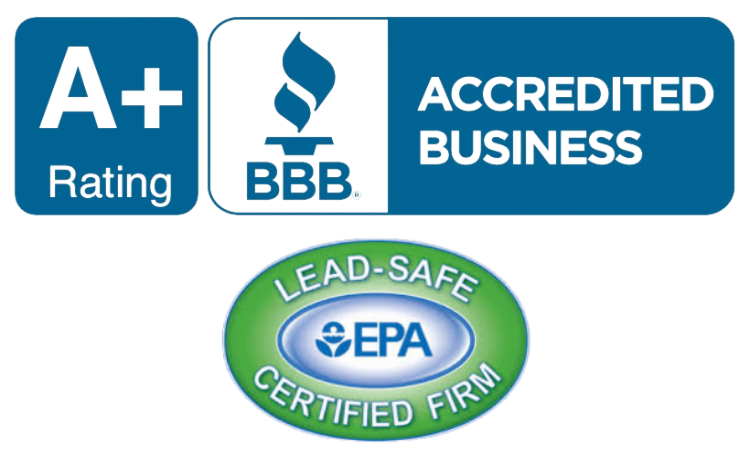Peeling of paint on the exterior of a house is a problem that many homeowners encounter. Paint fades over time when exposed to environmental conditions such as sunlight, rain, and snow, making the paint lose its color and become dull. This can result in the need for repainting more often.
Ultraviolet (UV) rays
Ultraviolet (UV) rays from the sun can penetrate the molecular structure of the paint and cause it to fade. Also, temperature changes can lead to the cracking and peeling of the paint as the materials expand and contract. Besides natural factors like weathering and fading, other factors that may cause paint to deteriorate include air pollution, acid rain, and other contaminants.
Cracking and Peeling
One of the main issues typical for homeowners who are painting the exterior of their houses is the issue of cracking and peeling of the paint. This may result from improper surface preparation, substandard paint, or even the application of paint in the wrong weather conditions. If the surface is not well prepared for painting–for instance, through cleaning and sanding–the paint may not adhere well and may start to chip off after some time.

Also, the use of poor-quality paint or painting in extreme temperatures can cause cracking and peeling of the paint as the paint may not be able to handle the conditions. Besides these factors, moisture can also be a significant cause of cracking and peeling of paint. If water can get under the paint, it will cause the paint to bubble and eventually peel off.
Mold and Mildew
When it comes to painting, mold and mildew growth on the exterior of your home can be a big issue. These blemishes not only affect the aesthetics of your home, but they also pose a threat to the paint and other surfaces of the exterior. Mold and mildew are most likely to grow in areas that are dark and damp, which is why they often appear on the exterior walls of a house that is in contact with water and does not receive much sunlight.
If not treated, mold and mildew will break down the paint and pose health risks to you and your family. Mold and mildew can grow on the exterior of your home for several reasons. Lack of proper ventilation, high humidity, and little or no exposure to sunlight are some of the factors that encourage the growth of mold and mildew.
Inadequate Surface Preparation
Another primary reason why painting the exterior of your home can be problematic is that the surface is not properly prepared. It is essential to prepare the surfaces that are to be painted in the proper manner so that the paint can adhere well and last for the desired time. This involves washing the surface to ensure that there is no dirt, grime, or any other form of contamination on the surface, and then sanding or priming to ensure the surface is smooth for the paint to adhere to.
If these steps are not followed or are done in the wrong way, it may cause some problems like paint peeling off or cracking, and poor adhesion of the paint to the surface. Besides cleaning and priming, it is also necessary to repair any defects on the surfaces that are to be painted. This may involve filling in cracks or holes, replacing damaged siding or trim, or dealing with any moisture problems.
Choosing the Wrong Paint
Another problem that is often seen when homeowners are painting the exterior of their homes is using the wrong type of paint. There are various kinds of exterior paints, and each type has its characteristics and uses depending on the surface that is to be painted. For instance, applying interior paint on the exterior surfaces of the house will result in the paint wearing out quickly due to exposure to weather conditions.

Lack of Proper Maintenance
It is advisable to have a maintenance schedule for the exterior of your home to avoid the aforementioned problems. This may involve cleaning with mild detergents or pressure washing to get rid of dirt and other debris and treating any mold or mildew growth as soon as possible.
It is also recommended to check the exterior of your home from time to time for any signs of damage or deterioration, like cracks, chipped paint, or stained areas. This way, you will be able to identify the problems and work on their solutions before they turn into more significant issues.
Environmental Factors
Some of the environmental factors that can affect the durability and the appearance of the exterior paint of your home include air pollution, acid rain, extreme temperatures, and UV radiation. These factors can lead to the fading, discoloration, and general deterioration of the paint film and other parts of your home that may be painted. In addition, the effects of water, such as rain, snow, or humidity, can also cause mold growth, paint peeling, and other problems.
The tips mentioned in this article are meant to help you protect the exterior paint of your home. The multiple common issues that might arise when painting the exterior of a home may include the paint fading or weathering away due to exposure to UV light and other chemicals; noticeable paint cracking or peeling due to poor surface preparation or moisture seepage; mold and mildew growth due to inadequate ventilation or moisture problems; using the wrong type of paint for the job; lack of proper maintenance; and environmental factors such as pollution and temperature changes.

